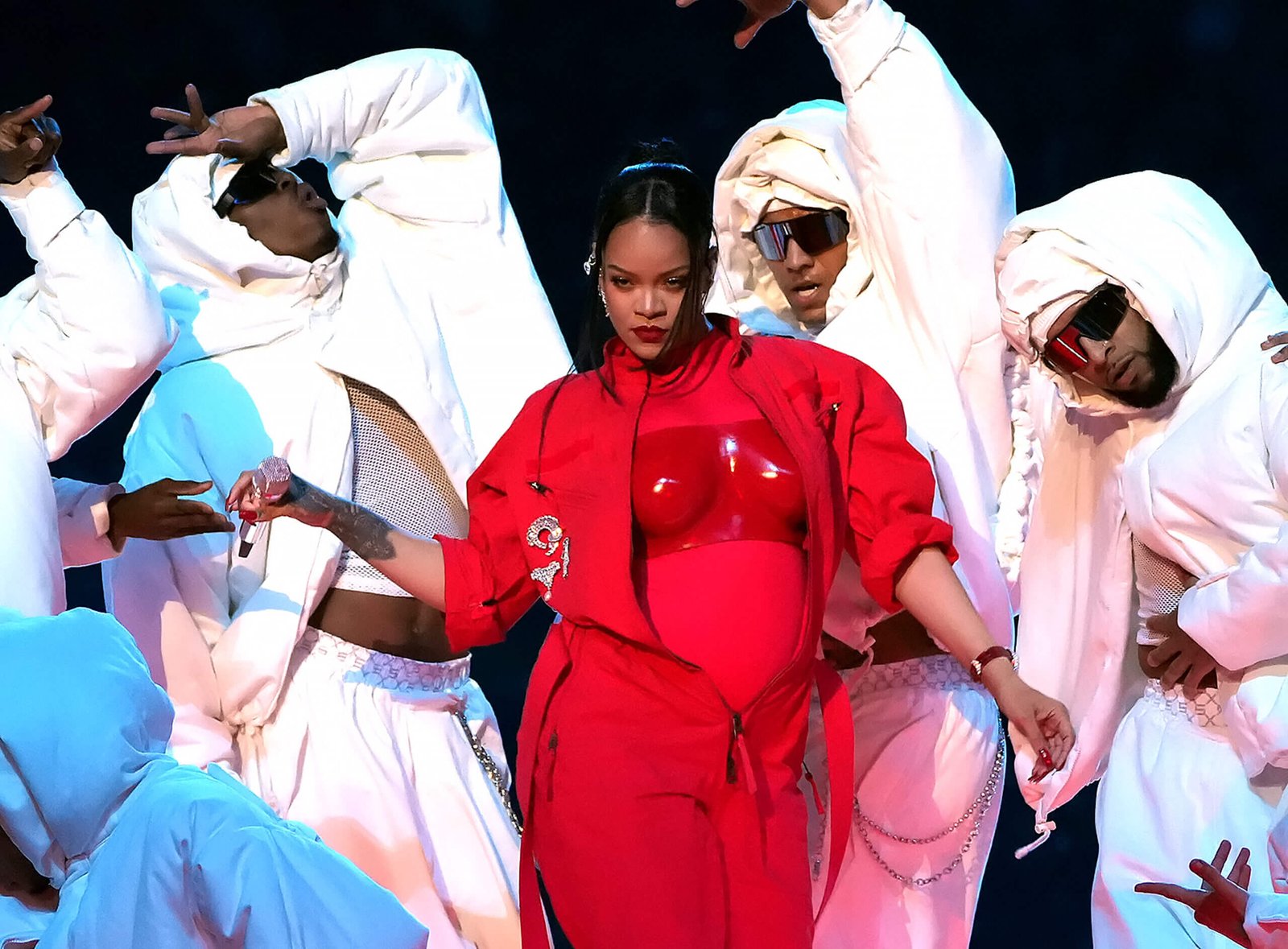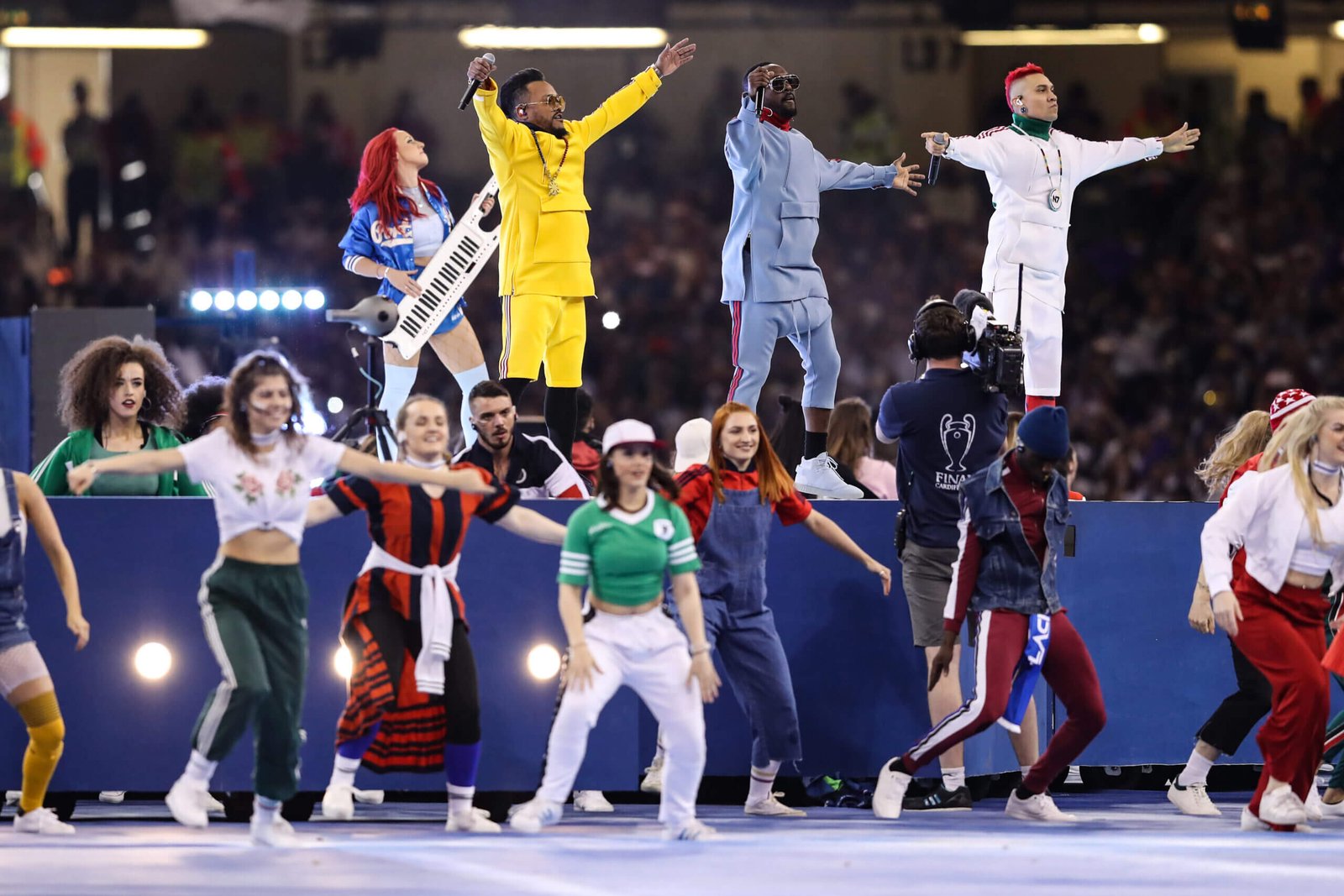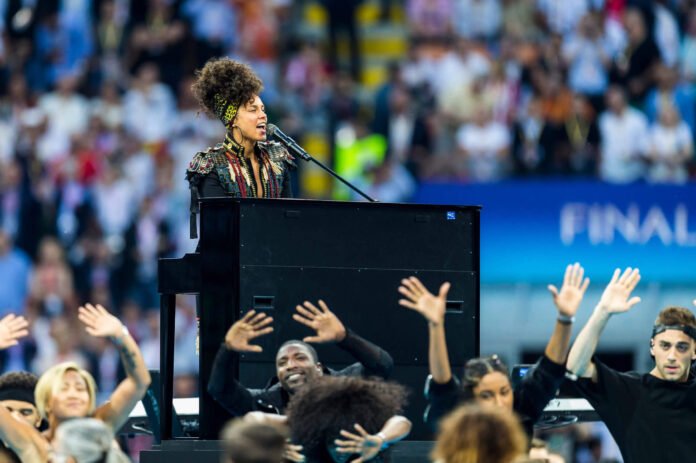It’s a warm early summer night in London, and the referee’s whistle ends a cagey first half between Manchester City and Real Madrid.
The Champions League final at Wembley Stadium hangs in the balance.
Erling Haaland got the first, then a controversial decision to award a penalty to Vinicius Junior saw Madrid level seconds before the break. Madrid coach Carlo Ancelotti shoved City assistant Juanma Lillo. Ederson was booked for kicking the ball at Federico Valverde.
The tension is palpable. There is plenty to discuss. But first… Ed Sheeran.
In the space of 15 half-time minutes, Ipswich’s finest is joined on stage by Coldplay, Take That and, briefly, Sir Elton John. There is glitz, glamour, fireworks and millions of euros in advertising revenue pouring in.
(Richard Calver/Getty Images)
Or perhaps it’s July in Berlin. Half-time at the European Championship final. The Olympic Stadium pitch is hastily being rearranged into a stage for Dua Lipa to rip through a 13-minute set of her hits and the world is tuning in.
Does it sound right? Would it work?
As the United States prepares for Sunday’s Super Bowl between the Kansas City Chiefs and San Francisco 49ers, an even wider audience is getting ready for its famous half-time show, which this year features R&B superstar Usher.
Previous performers at an event that regularly attracts more than 100million viewers across the world have included Michael Jackson, Madonna, Bruce Springsteen and Paul McCartney. It has more pull than Glastonbury’s main stage but in the space of 13, sometimes 15, dazzling, occasionally chaotic, minutes.
It is a tradition which stretches back to the 1970s (Ella Fitzgerald was the first major name to play a Super Bowl half-time in 1972). Before that, the entertainment at the interval largely consisted of marching bands and military-drill teams.
But since the 1990s, the Super Bowl half-time show has become a US pop-culture phenomenon, and provides artists lucky enough to be asked to take centre stage with an incredible career boost. According to Forbes, last year’s performer Rihanna saw a 390 per cent boost in song sales and a 211 per cent increase in streams from the Saturday before her Sunday night half-time show to the following Monday. Her performance also drew a record audience of 121 million viewers.

Rihanna performs at half-time of the 2023 Super Bowl (Kevin Mazur/Getty Images for Roc Nation)
Audiences seem to like it, the NFL benefits and accordingly the clubs cash in. With so many eyeballs to sell to, advertisers must be ecstatic too. So why hasn’t the half-time show, or something like it, been adopted in European soccer?
To begin with, it would require a significant shift to the traditional time frame of a football match.
“Normal NFL half-times last 15 minutes, like in football,” explains Tim Crow, a marketing consultant who works with several brands which sponsor European football’s governing body, UEFA, and FIFA, which looks after the global game. “The Super Bowl half-time show lasts up to 15 minutes itself and they need time to set up the stage before and de-rig it after, so the break becomes 30 minutes for that game.
“Football would have to follow suit — you’d have a half-hour half-time. The idea hasn’t been lost on the game’s global organising bodies. It’s why UEFA and FIFA have both pushed to extend half-time with the opportunities in mind.
“I think there’d be pushback from some in the game at that point. Football is different from NFL (which has) more frequent stoppages and offensive and defensive teams. In football, there would be questions over how you keep the players warm and tuned up for 30 minutes.”
There are also habitual differences between European football fans and NFL followers, which could explain why the show doesn’t go on (yet anyway) in Champions League finals et cetera.
“U.S. media has a lot more adverts,” explains Crow. “There can be 10-minute commercial breaks on American TV stations and their audience is used to it. In some ways, U.S. sport was built on a commercial model, as a vehicle to sell TV advertising.
“But in Europe, football was traditionally based around the fans in the stadium and then into public-service broadcasting (free to air), so there could still be a lower audience appetite and tolerance for the amount of ads that the Super Bowl half-time show contains.”
The Super Bowl half-time show regularly has higher viewing figures than the game itself, but in Europe those 90-plus minutes of action remain the prize according to Roger Bennett, founder of the Men In Blazers Media Network and a follower of both sports.
“European football has deep working-class roots,” Bennett says. “The game is the show. The atmosphere is fan-driven and fans travel across the continent to support their team.
“The NFL is profoundly different. First, American sport has always been comfortable with being packaged as entertainment. NFL in particular, because it came of age in the golden age of television and has long understood its success is all about spectacle in the eyes of the audience in their living rooms at home.
“Fans travel (to away games), but not in the same way and not with the noise and spectacle that can emerge from the Kop (at Liverpool’s stadium, Anfield) or (German club Borussia Dortmund’s) Yellow Wall.
“So to make noise, and create atmosphere or the sufficient buzz to hold the casual audience who could lose interest during the lull of half-time, unleashing Prince or The Rolling Stones makes a lot of sense for (TV) viewers who are really just there to savour the commercials.
“European football has not had to work so hard to remain a cultural juggernaut. The product has always been the game itself.”
That is not to say football has not tried to add some beefed-up entertainment to its pre- or mid-game broadcast.
At the onset of Sky Sports’ Monday Night Football programme in the early 1990s, the broadcaster attempted to package their new product with a little showbiz. Scottish electronic dance band The Shamen performed their No 1 hit Ebeneezer Goode at half-time of a game between Arsenal and Manchester City.
When sky sports introduced the new Monday night football! The Shamen signing Ebeneezer Goode at Highbury in 1992. The memories! Needless to say this half time entertainment was binned after about 6 months 😂#highbury #theshamen #arsenal #sky #MNF pic.twitter.com/hVZ31bRB0d
— Arsenal Nostalgia (@arsenal_vids) February 7, 2018
They were accompanied by a team of U.S.-style cheerleaders known as the Sky Strikers, but both were loudly booed by the crowd and The Shamen cut short their performance.
Subsequent musical interludes in Sky’s Monday games were phased out within months, although the Strikers continued to perform for the rest of that first 1992-93 Premier League season before also being stopped.
Pre-game entertainment has remained in various forms, gathering pace in the modern era of ‘fan zones’ with live music, interviews and other performances, but they are aimed at pulling supporters, and their wallets, into stadiums earlier rather than at the TV audience.
“When UEFA signed Pepsi, who for many years sponsored the Super Bowl half-time show, they pushed for a pre-game show at big games,” says Crow. “They weren’t particularly successful, especially at the start.
“Alicia Keys performed before the 2015-16 Champions League final (top photo), which didn’t quite have the desired effect. The following season it was the Black Eyed Peas, minus Fergie, for the Champions League final at the Principality Stadium in Cardiff. Someone like (Welsh indie rock group) the Manic Street Preachers might have made more sense.”

The Black Eyed Peas perform before the 2017 Champions League final in Cardiff (Jonathan Moscrop/Getty Images)
Occasionally, the choices struck a better note. Crow points out that Dua Lipa, who played the opening ceremony of the Champions League final in Kyiv, where Liverpool were playing Real Madrid, went on to have her hit One Kiss adopted by supporters of the Merseyside club, who sang along with her on the night in a moment that went viral on social media.
Beyond Europe, other footballing countries have been quicker to accept half-time shows. South Africa’s domestic cup competition, the Nedbank Cup, has regular televised half-time shows for its final with marching bands, dancers and live pop performances.
Remember when we had our very own Super Bowl half time show?🥹 pic.twitter.com/FImJovVkr3
— Paballo❄️ (@paballo_maseko) February 4, 2024
And such slices of entertainment might still reappear at football’s biggest games. In the Premier League today (Saturday), boyhood Tottenham fan and rising singer-songwriter Declan McKenna will perform songs from his new album at half-time of their home game against Brighton.
“The more commercial football becomes,” adds Bennett, “the more it is conceivable to imagine, say (FIFA president) Gianni Infantino, who just awkwardly hung out with Drake during the (2026) World Cup stadium reveal, importing the tradition to the World Cup and unleashing the Black Eyed Peas on all comers.”
Ed Sheeran, get ready.
In the end, money might talk, sing and dance its way into making half-time shows a European football ‘thing’.
(Top photo: Michael Campanella/Getty Images)
Read the full article here


